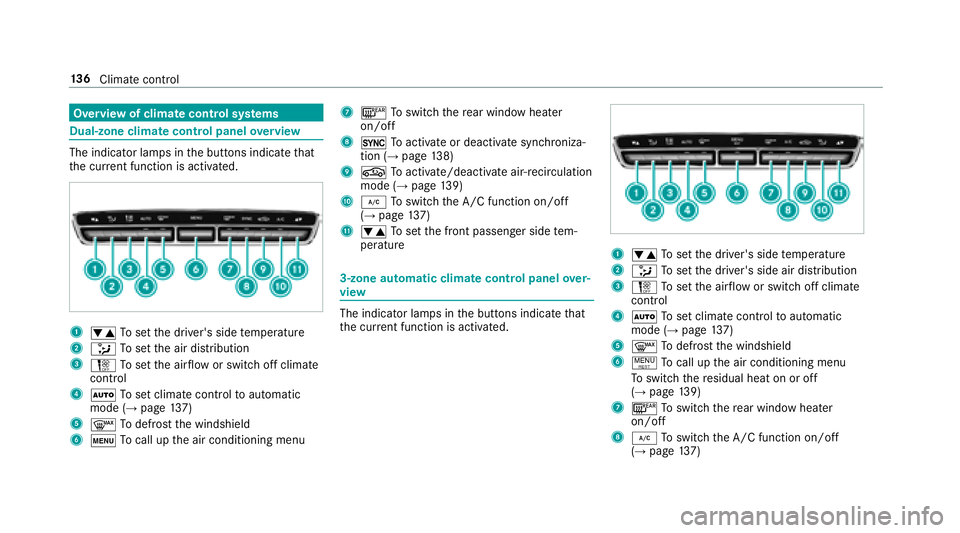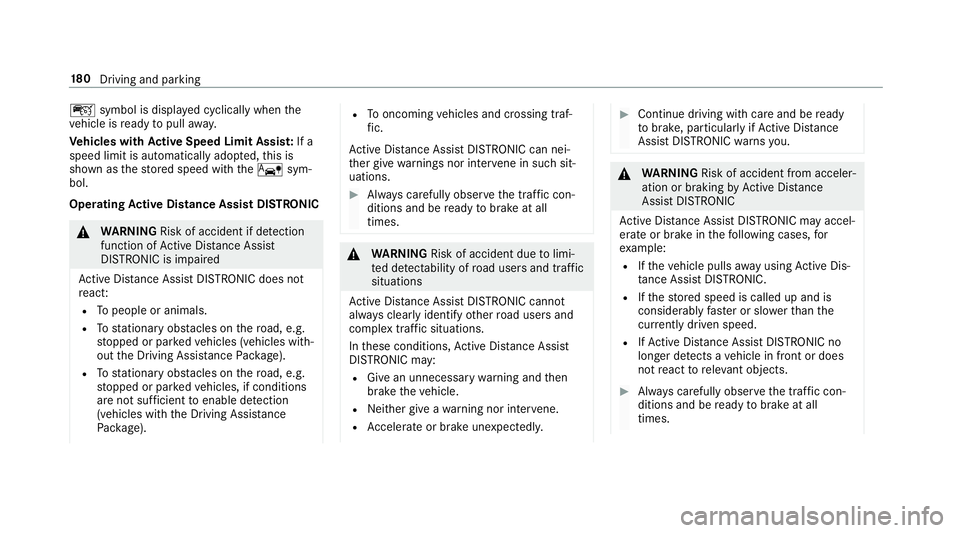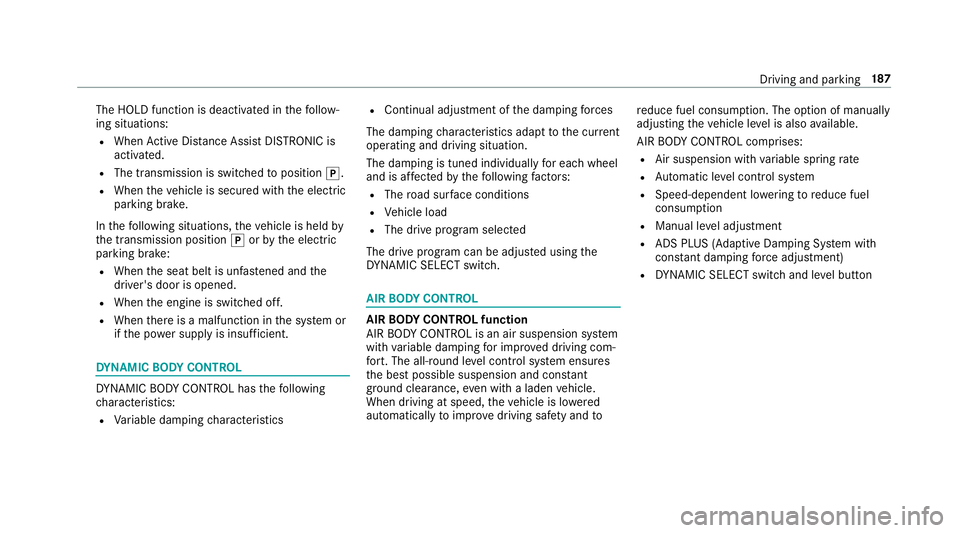2018 MERCEDES-BENZ E-CLASS WAGON air condition
[x] Cancel search: air conditionPage 138 of 506

Overview of climate control systems
Dual-zone clima tecontro l panel overview
The indicator lamps in the buttons indicate that
th e cur rent function is acti vated.
1w Toset the driver's side temp erature
2_ Toset the air distribution
3H Toset the air flow or switch off climate
contro l
4ÃToset climate contro lto automatic
mode (→page 137)
5¬ Todefrost the windshield
6t Tocall up the air conditioning menu
7¤ Toswitch there ar wind owheater
on/off
80 Toactivate or deactivate synchro niza‐
tion (→pa ge 138)
9g Toactivate/deactivate air-reci rculation
mode (→page 139)
A¿ Toswitch the A/C function on/off
(→page 137)
Bw Toset the front passenger side tem‐
perature
3-zone automatic climate control panel over‐
view
The indicator lamps in the buttons indicate that
th e cur rent function is acti vated.
1w Toset the driver's side temp erature
2_ Toset the driver's side air distribution
3H Toset the air flow or switch off climate
contro l
4ÃToset climate contro lto automatic
mode (→page 137)
5¬ Todefrost the windshield
6! Tocall up the air conditioning menu
To switch there sidual heat on or off
(
→page 139)
7¤ Toswitch there ar wind owheater
on/off
8¿ Toswitch the A/C function on/off
(→page 137)
13 6
Climat e control
Page 146 of 506

#Toswitch on the po wer supp ly:press but‐
to n1 (USA) or 2(Canada) once.
Yo u can act ivate the windshield wiper, for
ex ample.
The po wer supp lyis switched off again if thefo l‐
lowing conditions are me t:
RThe driver's door is open.
RYou press butto n1 (USA) or 2(Canada)
twice.
#To switch on the ignition: press button 1
(USA) or 2(Canada) twice.
The indicator lamps in the instrument clus ter
light up.
The ignition is switched off again if one of the
fo llowing conditions is me t:
RYou do not start theve hicle within
15 minutes.
RYou press butto n1 (USA) or 2(Canada)
once.
St arting theve hicle
Starting theve hicle with thest art/s top but‐
to n
Requ irements
RThe SmartK eyis located in theve hicle and
th e SmartK eybattery is not dischar ged.
#Shift the transmission toposition jori.
#Depress the brake pedal and push button 1
(USA) or 2(Canada) once.
#Ifth eve hicle does not star t:switch off non-
essential consumers and press button 1
(USA) or 2(Canada) once.
#Ifth eve hicle still does not start and the
�3�O�D�F�H �W�K�H �.�H�\ �L�Q �W�K�H �0�D�U�N�H�G �6�S�D�F�H �6�H�H
�2�S�H�U�D�W�R�U�
�V �0�D�Q�X�D�O display message also
appears in the multifunction display: start
th eve hicle in emer gency operation mode.
Yo u can switchoff the engine while driving by
pressing button 1(USA) or 2(Canada) for
about thre e seconds. Be sure toobser vethe
saf etyno tes under "Driving instructions".
St arting theve hicle via Remo teOnline serv‐
ices
Cooling or heating theve hicle interior before
st arting the journey
If yo ustart theve hicle via your smartphone, the
pr ev iously selecte d air conditioning adjustment
is active.
14 4
Driving and pa rking
Page 168 of 506

Drivingand drivin gsaf ety sy stems
Driving sy stems and your responsibility
Yo ur vehicle is equipped with driving sy stems
which assist youin drivin g, parking and maneu‐
ve ring theve hicle. The driving sy stems are aids
and do not relie ve you of your responsibility. Pay
attention tothe tra ffic conditions at all times
and inter vene when necessary . Beaware of the
limitations rega rding the safe use of these sys‐
te ms.
Fu nction of thera dar senso rs
Some driving and driving safe ty systems use
ra dar sensors tomonitor the area in front of,
behind or next totheve hicle (depending on the
ve hicle's equipment).
Depending on theve hicle's equipment, thera dar
sensors are integrated behind the bumpers
and/or behind thera diator grill. Keep these
parts free of dirt, ice and slush (
→page 336).
The sensors must not be co vered, forex ample
by bicycle rack s, overhanging loads or radar-
re flecting sticke rs.Fo llowing an impact and in th
eeve nt of associated damage , which may not
be visible, tothe bumpers or radiator grille, ha ve
th e function of thera dar sensors checked at a
qu alified specialist workshop. The driver assis‐
ta nce sy stem may no longer workproperly.
Overview of driving sy stems and driving
saf ety sy stems
In this section, you will find information about
th efo llowing driving sy stems and driving saf ety
sy stems:
R360° Camera (→page 196)
RABS ( Anti-lock BrakingSystem)
(→page 166)
RAc tive Dis tance Assist DISTRONIC
(→pa ge 177)
RAIR BODY CONTROL(→page 187)
RAc tive Brake Assi st(→page 170)
RAc tive Lane Keeping Assist (→page 211)
RAT TENTION ASSIST (→page 205)
RBA S (Bra keAssist System) (→page 167)
RDY NA MIC BODY CONTROL (→page 187)
REBD ( Electronic Brakeforc eDistribution)
(→page 170)
RESP®(E lectronic Sta bility Program)
(→page 167)
RHOLD function (→page 186)
RSTEER CONTROL (→page 170)
RAc tive Steering Assist (→page 183)
RAc tive Parking Assist (→page 199)
RParking Assist PARKTRONI C (→page19 0)
RRe ar view camera (→page 194)
RCruise control (→page 175)
RBlind Spot Assist andActive Blind Spot Assi st
(→page 208)
RTr af fic Sign Assist (→page 206)
Functions of ABS (anti-lock braking sy stem)
ABS regulates the brake pressure in critical driv‐
ing situations:
RDuring braking, e.g. at maximum full-s top
braking or insuf ficient traction of the tires,
th e wheels are pr evented from blocking.
16 6
Driving and pa rking
Page 169 of 506

RVehicle steerability while braking is ensured.
If ABS inter venes when braking, youwill feel a
pulsing in the brake pedal. The pulsating brake
pedal can be an indication of hazardous road
conditions and can ser veas a reminder totake
ex tra care while driving.
Sy stem limitations
RABS is active from speeds of appr ox. 5 mph
(8 km/h).
RABS may be impaired or may not function if a
malfunction has occur red and theye l‐
low ! ABSwarning lamp lights up contin‐
uously in the instrument clus ter af terth e
engine is star ted.
Fu nction of BAS (Brake Assist Sy stem)
&
WARNING Risk of an accident caused by
a malfunction in BAS (Brake Assist Sys‐
te m)
If BA S is malfunctioning, the braking dis tance
in an emergency braking situation is
increased.
#Depre ssthe brake pedal with full forc e
in emer gency braking situations. ABS
pr eve nts the wheels from locking.
BA S suppo rts yo ur eme rgency braking situation
with additional brake forc e.
If yo u depress the brake pedal quickl y,BA S is
acti vated:
RBA S au tomatical lyboosts the brake pres‐
sure.
RBA S can short enthe braking dis tance.
RABS pr events the wheels from locking.
The brakes will function as usual once you
re lease the brake pedal. BAS is deactivated.
Functions of ESP®(Electronic Stability Pro‐
gr am)
&
WARNING Risk of skidding if ESP®is
malfunctioning
If ESP
®is malfunctioning, ESP®cannot car ry
out vehicle stabilization. In addition, other
driving saf etysy stems are switched off.
#Drive on carefull y.
#Have ESP®checked at a qualified spe‐
cialist workshop.
&
WARNING Risk of skidding if ESP®is
deactivated
If yo u deactivate ESP
®, ESP®cannot car ry
out vehicle stabilization.
#ESP®should only be deactivated in the
fo llowing situations.
ESP®monitors and impr oves driving stability and
traction, particular ly inthefo llowing situations:
RWhen pulling away on wet or slippe ryroads.
Driving and parking 16
7
Page 180 of 506

taking on the left in left-hand tra ffic on free ways
and high-speed major roads.
If yo u act ivate the turn signal indicator tochange
lanes, theve hicle will accelerate more briskly to
th e set speed under thefo llowing conditions:
RAc tive Dis tance Assist DISTRONIC is acti va‐
te d.
RIfth e driving speed is higher than 45 mph
(70 km/h).
RIf th e driven speed drops below thestored
speed.
RThe sy stem cannot detect a vehicle in there l‐
ev ant area of theov ertak ing lane.
Ve hicles with Driving Assistance Package
and Traf fic Sign Assis t:Ac tive Dis tance Assist
DISTRONIC also has theAc tive Speed Limit
Assi stfunction. This function can be configure d
in the multimedia sy stem. If a change in the
speed limit is de tected and Active Dis tance
Assist DISTRONIC is acti vated, Ac tive Dis tance
Assist DISTRONIC assumes this new speed.
The driven speed is adap ted when theve hicle is
le ve l with the tra ffic signs. The speed limit dis‐ play in
the Instrument Display is alw ays update d
when theve hicle is le vel with the tra ffic sign.
If Ac tive Dis tance Assist DISTRONIC has been
put into passive modebypressing the accelera‐
to r pedal, only speed limits which are higher
th an the set speed ar e adop
ted.
Pullin
g th e cruise control le ver will set the dis‐
pla yed speed limit as the speed, pr ovided that:
RAc tive Speed Limit Assi sthas been activated
in the multimedia sy stem and
RAc tive Dis tance Assist DISTRONIC has been
acti vated
If no speed limit is display ed whenthe le ver is
operated, the speed set bythe driver is adop ted.
Drive prog ram
The DYNA MIC SELECT switch allo wsyouto
ch ange the driving style of Active Dis tance
Assist DISTRONIC. Depending on which drive
prog ram is selected, the driving characteristics
can be geared towa rds fuel econom y,comfort or
dynamic per form ance (
→page 150). Sy
stem limitations
Ve hicles with the Driving Assistance Pack‐
age: Active Dis tance Assist DISTRONIC is acti ve
in the 0 mph(0 km/h) to130mp h(210 km/h)
speed range.
The sy stem may be impaired or may not function
in thefo llowing ins tances, forex ample:
RIn snow ,ra in, fog, heavy spr ay, if there is
gl are, in direct sunlight or in greatlyvarying
ambient light.
RThe windshield in the area of the camera is
dirty, fogged up, damaged or co vered.
RIfth era dar sensors are dirty or co vered.
ROn slippery roads, braking or accelerating
can cause the drive wheels tolose traction
and theve hicle could then skid.
RIn parking garage s,tollst ations or on roads
with steep uphill or downhill gradients.
Do not use Active Dis tance Assist DISTRONIC in
th ese situations.
17 8
Driving and pa rking
Page 182 of 506

çsymbol is displa yed cyclically when the
ve hicle is ready topull away.
Ve hicles with Active Speed Limit Assi st:If a
speed limit is au tomatical lyadop ted, this is
shown as thestored speed with theê sym‐
bol.
Operating Active Di stance Assist DI STRO NIC
&
WARNING Risk of accident if de tection
function of Active Dis tance Assist
DISTRONIC is impaire d
Ac tive Dis tance Assist DISTRONIC does not
re act:
RTo people or animals.
RTostationary obstacles on thero ad, e.g.
st opped or par kedve hicles (vehicles with‐
out the Driving Assis tance Package).
RTo stationary obstacles on thero ad, e.g.
st opped or par kedve hicles, if conditions
are not suf ficient toenable de tection
(vehicles wi th the Driving Assis tance
Pa ckage).
RTo oncoming vehicles and crossing traf‐
fi c.
Ac tive Dis tance Assist DISTRONIC can nei‐
th er give warnings nor inter vene in such sit‐
uations.
#Alw ays carefully obser vethe traf fic con‐
ditions and be ready tobrake at all
times.
& WARNING Risk of accident due tolimi‐
te d de tectability of road users and traf fic
situations
Ac tive Dis tance Assist DISTRONIC cannot
al wa ys clear lyidentify other road users and
complex traf fic situations.
In these conditions, Active Dis tance Assist
DISTRONIC may:
RGi ve an unnecessary warning and then
brake theve hicle.
RNeither give a warning nor inter vene.
RAc celerate or brake unexpectedly.
#Continue driving wi thcare and be ready
to brake, particular lyifAc tive Dis tance
Assist DISTRONIC warnsyo u.
&
WARNING Risk of accident from acceler‐
ation or braking byActive Dis tance
Assist DISTRONIC
Ac tive Dis tance Assist DISTRONIC may accel‐
erate or brake in thefo llowing cases, for
ex ample:
RIfth eve hicle pulls away using Active Dis‐
ta nce Assist DISTRONIC.
RIfth estored speed is called up and is
considerably faster or slo werth an the
cur rently driven speed.
RIfAc tive Dis tance Assist DISTRONIC no
longer de tects a vehicle in front or does
not react toreleva nt objects.
#Alw ays carefully obser vethe traf fic con‐
ditions and be ready tobrake at all
times.
18 0
Driving and pa rking
Page 186 of 506

RIfth e lane markings change quickl y,e.g.
lanes branch off, cross one ano ther or
mer ge.
RThe road is nar row and winding.
RIfth ere are highly variable shade conditions
on thero ad.
RIfth ere are obs tacles such as object mar kers
on the lane or projecting out into the lane.
The sy stem does not pr ovide assis tance in the
fo llowing conditions:
ROn very sharp bends.
RWhen towing a trailer.
RIfyo u act ively change lane without switch ing
on the turn signal indicator.
RIfyo uswit chon the turn signal indicator and
th e conditions for activating Active Lane
Change Assi stare not fulfilled.
Ac tivating Active Steering Assist
Requ irements:
RESP®must be activated, but not inter vening.
RAc tive Dis tance Assist DISTRONIC must be
activated.
#If indicator lamp 1is off: press button 2.
Fu nction of Active Lane Change Assi st
Ac tive Steering Assist is only an aid. You are
re sponsible forth e dis tance totheve hicle in
front, forve hicle speed, for braking in good time
and forst ay ing in lane. Before changing lanes, make sure
that the neighboring lane is free
(shoulder view).
% The availability of thefo llowing function is
countr y-dependent.
Ac tive Steering Assist remains active even if the
turn signal indica tor is switched on. Active Steer‐
ing Assist then assists the driver when changing
lanes byapplying steering torques toinitiate the
lane change.
Assis tance when changing lanes is pr ovided if all
th efo llowing conditions are me t:
RYou are driving on a free wayor high-speed
multi-lan emajo rro ad with multiple lanes in
th e direction of tr avel.
RThe neighboring lane is free and separated
bya broken lane marking.
RThe driven speed is between 50 mph
(80 km/h) and 110mp h(1 80 km/h).
RThe turn signal indicator is switched on for
longer than two seconds.
If th e sy stem is impaired, Active Lane Change
Assi stmay be inter rupte d. If an inter ruption
occurs, display 1appears in the multifunction
18 4
Driving and pa rking
Page 189 of 506

The HOLD function is deactivated inthefo llow‐
ing situations:
RWhen Active Dis tance Assist DISTRONIC is
acti vated.
RThe transmission is switched toposition j.
RWhentheve hicle is secured with the electric
parking brake.
In thefo llowing situations, theve hicle is held by
th e transmission position jorby the electric
parking brake:
RWhen the seat belt is unfas tened and the
driver's door is opened.
RWhen the engine is switched off.
RWhen there is a malfunction in the sy stem or
if th e po wer supply is insufficient.
DY NA MIC BODY CONT ROL
DYNA MIC BODY CONTROL has thefo llowing
ch aracteristics:
RVa riable damping characteristics
RContinual adjustment of the damping forc es
The damping characteristics adapt tothe cur rent
operating and driving situation.
The da mping is tuned individually for each wheel
and is af fected bythefo llowing factors:
RThe road sur face conditions
RVe hicle load
RThe drive program selected
The drive program can be adjus ted using the
DY NA MIC SELECT switch.
AIR BODY CONT ROL
AIR BODY CONT ROL function
AIR BODY CONTROL is an air suspension sy stem
with variable damping for impr oved driving com‐
fo rt. The all-round le vel control sy stem ensures
th e best possible suspension and const ant
ground clearance, even with a laden vehicle.
When driving at speed, theve hicle is lo wered
automatically toimpr ovedriving saf etyand to re
duce fuel consum ption. The option of manually
adjusting theve hicle le vel is also available.
AIR BODY CONTROL comprises:
RAir suspension with variable spring rate
RAu tomatic le vel control sy stem
RSpeed-dependent lo wering toreduce fuel
consum ption
RManual le vel adjustment
RADS PLUS (Adaptive Damping Sy stem with
const ant damping forc e adjustment)
RDY NA MIC SELECT switch and le vel button
Driving and parking 18
7